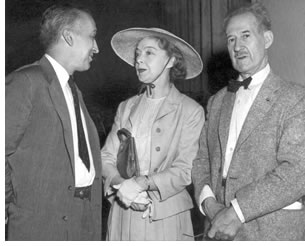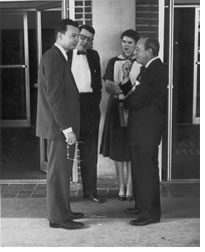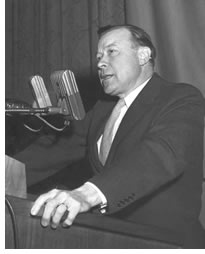

by Andrew Brodie Smith
In the spirit of celebration and with great expectancy, members of
the AIA gathered for their Centennial Convention at the Sheraton
Park Hotel in the leafy Woodley Park neighborhood of Washington,
D.C. It was the spring of 1957, and the occasion couldn’t have
been more auspicious. Membership in the Institute had been surging
since WWII, and the construction industry was booming throughout
the U.S. Architects had plenty of work and the Institute’s
coffers were full. There was much to honor in the Institute’s
illustrious past, and the future looked bright.
AIA President Leon Chatelain read a letter to the assembled from
President Eisenhower congratulating the Institute on its 100-year
anniversary. Vice President Richard Nixon sent a telegram, too. The
Institute had gathered a group of illustrious non-architect
speakers and guests for the occasion, unrivaled since the time,
nearly 50 years earlier, when President Theodore Roosevelt made an
appearance at a ceremony honoring Augustus Saint-Gaudens held as
part of the AIA’s 1908 Convention.
Bennet Cerf, leading literary light of New York and the publisher
of Random House, gave an uproariously funny address about the
current state of the publishing industry. Dr. Howard Mitchell,
conductor of the National Symphony Orchestra, prepared a special
program of music, “Music and Architecture in the Environment
of Man,” that the NSO performed. Other speakers included Time,
Inc.’s editor in chief Henry R. Luce and actress Lillian Gish.
David Brinkley, later to become an Honorary AIA member, was on hand
to cover the event for NBC television. The Centennial Convention
was a true celebration of The Institute in particular and American
arts in general.
 UAW President
Reuther raises a red flag
UAW President
Reuther raises a red flag
Amidst the celebration walked in Walter P. Reuther, the feisty and
world-renowned president of the United Auto Workers and leading
figure in the AFL-CIO merger. He had been invited to speak to the
convention as part of a panel called “The New World of
Economics.” Reuther was to share the dais with Emerson P.
Schmidt of the U.S. Chamber of Commerce and James Ashely, public
relations director for the glass company Libbey-Owens-Ford. The
panel was to be moderated by former Pepsodent
president-turned-architect Charles Luckman.
Ever the social crusader, Reuther wasn’t of the mind to throw
bouquets at the Institute in honor of its 100 years. After all,
that was not why he had been invited. His address came more in the
way of a challenge than a celebration.
“It is not a lack of economic resources,” he said,
“or a lack of technical competence. It is a lack of moral
courage and will to commit our resources to build decent
neighborhoods where people can grow up in the kind of environment,
in the kind of wholesome neighborhoods so that they can enjoy the
good life and they can develop into better and more useful citizens
… The people of the world will judge America as we need to
judge ourselves—not by our economic wealth but by the sense of
social and moral responsibility by which we are able to equate
material wealth with human values, by which we are able to
translate technical progress into human progress, into human
happiness, into human dignity.”
To the extent that the AIA had long been committed to the
improvement of the built environment for all Americans regardless
of class, Reuther was preaching to the choir. However, he
hadn’t accepted the invitation only to air his social vision
to a gathering of architects. He likely had something more specific
in mind. The year before, the UAW had run afoul of the AIA. The
union had for some time been organizing workers at the Kohler
Company—a well-known Wisconsin plumbing-fixtures firm with a
storied history of labor-relations strife.
 Origins of the
controversy
Origins of the
controversy
UAW-CIO Local 833, the local union active at Kohler, got the idea
to send letters to architects around the country asking them to
boycott the company’s products in support of the striking
workers. Members of the Institute received the letters and alerted
the national office of the campaign. The AIA was an organization
that long considered itself progressive on the question of labor.
It had maintained an open and cooperative dialogue with building
and allied trades and saw the cause of labor as not inimical to the
overall health of the construction industry.
The brand new AFL-CIO headquarters on 16th Street in Washington
stood as further testament to the good relations between the
Institute and organized labor, designed as it was by Ralph Walker,
beloved former president of the Institute and the recipient of that
year’s AIA Centennial Gold Medal. But, clearly, the AIA could
not countenance the kind of interference with the architect/client
relationship that the efforts of Local 833 at Kohler
represented.
To ask an architect not to specify a particular brand of building
product would be like asking physicians not to dispense a
much-needed medication. Alarmed, AIA Executive Director Edmund
Purves and AIA President George Bain Cummings called a meeting with
Richard Gray, president of the AFL Building and Construction Trades
Department, and Emil Mazy, UAW secretary. In the meeting, the union
leaders agreed to ask Local 833 to cease its letter writing
campaign.
The story would have ended there if not for the fact that union
leaflets regarding the labor problems at the Kohler plant had
mysteriously appeared on all the chairs in the ballroom prior to
the panel presentation. Reuther denied any involvement in the
placing of the literature. Hotel management couldn’t explain
its presence either. The pamphlets were already on the chairs when
the ballroom was opened at seven in the morning. Moreover, Reuther
made a statement during his address to the Institute meant
deliberately to force the issue.
“We in the labor movement,” he said, “believe that
every child made in the image of God has the right to grow limited
only by the capacity that God gave each child to grow. I say
there’s something wrong with the basic moral fiber of a free
society that is more concerned with the condition of its plumbing
than with the adequacy of its educational system.”
 “The
condition of its plumbing”
“The
condition of its plumbing”
Certainly a man of Reuther’s political stripe and
sophistication wasn’t arguing against the importance of modern
sanitation. There was only one likely interpretation: the UAW
president was taking a veiled dig at the AIA regarding its response
to the Kohler boycott efforts. The thought must have been running
through the minds of almost every architect in attendance.
The panel’s question-and-answer period was to be handled via
hand-written questions submitted from the audience. Moderator
Luckman read the fifth question: “Mr. Reuther, how does the
secondary boycott raise the moral and spiritual values that you
talk about?” Someone had taken the bait.
Reuther pounced. “I presume the reference to secondary boycott
refers to the current Kohler strike, and I am sure that all of you
in your professional activities have had some contact with this
problem.” He proceeded to methodically lay out the
union’s case against Kohler, beginning with the bloody events
of 1934 when Kohler’s company guards opened fire on striking
and rioting workers, killing 2 and wounding more than 30.
He brought up the problem of silicosis and other workers’
health problems at the factory. He mentioned the company’s
infamous intransigence, refusing to accept a proposal for
arbitration even from Wisconsin Governor Walter Kohler
Jr.—owner Herbert Kohler Sr.’s own nephew. He brought up
Kohler’s admission before the Wisconsin State Mediation Board
that the company still maintained a private arsenal of weapons
despite the tragedy of some 20 years earlier.
Reuther could barely contain his indignation: “This is a moral
question, to persuade people to not use Kohler fixtures … We
say so long as this company is going to act irresponsibly and
immorally, we are going to do everything we can to persuade people
not to use Kohler fixtures so that we can protect the economic
interest and well being of the workers who are merely asking for
their measure of economic and social justice.”
The audience applauded as Reuther finished. Letter-writing campaign
or no, the UAW president had won the day, successfully and
dramatically articulating his union’s position to a captive
ballroom filled with the most influential architects in the
country.
 Civil rights
make their AIA-convention premiere
Civil rights
make their AIA-convention premiere
The labor problems at Kohler aside, Reuther’s address to the
AIA is notable for another reason. Those paying careful attention
would have heard the UAW president use the term “civil
rights”—likely the first public mention of the issue at
an AIA national convention. And in this regard, Reuther sounded a
note that would resonate for decades to come both at the Institute
and in American society as a whole.
What happened at Kohler? It took another eight years, one of the
longest strikes in UAW’s history, and among the most
protracted cases before the National Labor Relations Board, but the
UAW eventually prevailed. Kohler would recognize the union and
agreed to pay workers $3,000,000 in back pay and another $1,500,000
in restored pension rights. As to whether any of the architects in
attendance that morning during Reuther’s speech furthered the
UAW’s cause by limiting their specification of Kohler
products, that can only be a matter of conjecture.
A final note
In 1970, The AIA invited Reuther once more to address its
Convention. He was to give the prestigious Purves Memorial Lecture.
Tragically, this command performance was never to occur, as a month
before the event, Reuther and his wife were killed in a plane crash
en route to inspect the UAW’s new education center at Black
Lake, Michigan. The AIA lost one of it own aboard the downed jet
also: Oscar Stonorov, an Institute Fellow and the center’s
architect. An AIA memo memorializing the union leader said,
“many of the ideals and policies he championed came to pass
and are now accepted as part of the American Way of Life with
hardly a ripple of opposition or concern. We have lost a voice of
social concern and, yes, professional responsibility.” Upon
his death, the Board of Directors of The AIA established a
scholarship for disadvantaged students in his memory.
Copyright 2005 The American Institute of Architects. All rights reserved. Home Page

